Japandi Bedroom Ideas: Create Your Serene & Minimalist Sleep Sanctuary
Imagine stepping into a bedroom that effortlessly combines the minimalist elegance of Japanese aesthetics with the warm, inviting comfort of Scandinavian design. This harmonious fusion is the essence of Japandi style, a highly sought-after trend in modern home decor, particularly popular for creating tranquil sleep environments. Japandi bedrooms are characterized by their clean lines, an abundance of natural materials, and a soothing, muted color palette, all working together to foster incredibly peaceful and restorative spaces.
If you’re seeking to refresh your bedroom and transform it into a haven of calm, Japandi design offers an ideal balance of both form and function. This unique style encourages you to strip away unnecessary clutter and focus only on what is essential, allowing you to cultivate a truly serene retreat from the demands of the busy external world. It’s about finding beauty in simplicity and embracing a more mindful way of living.
This comprehensive guide will delve deep into inspiring Japandi bedroom ideas that can profoundly transform your personal sleep space. From carefully selecting the perfect color palette and choosing the right furniture to incorporating subtle decor elements, you’ll discover actionable strategies to seamlessly integrate this distinctive minimalist style into your home. Prepare to explore how Japandi design can help you craft not just a beautiful, but also a deeply restful and calming bedroom environment, promoting unparalleled relaxation and well-being.
Understanding the Essence of Japandi Bedroom Design
Japandi design is a masterful blend of two distinct yet complementary styles: the rustic modernity of Scandinavian ‘hygge’ and the timeless elegance of Japanese ‘wabi-sabi’. The result is a look that is both refreshingly simple and profoundly cozy, bringing together the best philosophical elements of both cultures. In a Japandi bedroom, you will discover a seamless integration of sleek, clean lines with wonderfully warm, inviting touches. This style purposefully takes the most appealing aspects of both worlds – the disciplined neatness and functional beauty of Japanese design, and the inherent comfort and natural feel of Nordic interiors.
Key features that define the tranquil beauty of Japandi bedrooms include:
- A Harmonious Neutral Color Palette: Predominantly featuring soft greys, warm whites, gentle beiges, and a range of natural earth tones. These colors create a calming and expansive backdrop.
- Emphasis on Natural Materials: A celebration of organic elements such as light-toned wood (like oak, birch, ash), bamboo, rattan, natural stone, ceramics, and textiles like linen, cotton, and wool.
- Uncluttered, Intentional Spaces: A strong focus on minimalism, where every item is carefully chosen for its purpose, beauty, or both. This approach promotes a sense of order and tranquility.
- Functional Simplicity: Furniture and decor are designed with practicality in mind, often featuring clean lines and a lack of excessive ornamentation.
By embracing these principles, Japandi style helps to create a truly calm, peaceful, and balanced bedroom where you can genuinely relax, recharge, and find personal sanctuary.
How Japandi Design Uniquely Differs from Scandinavian Style
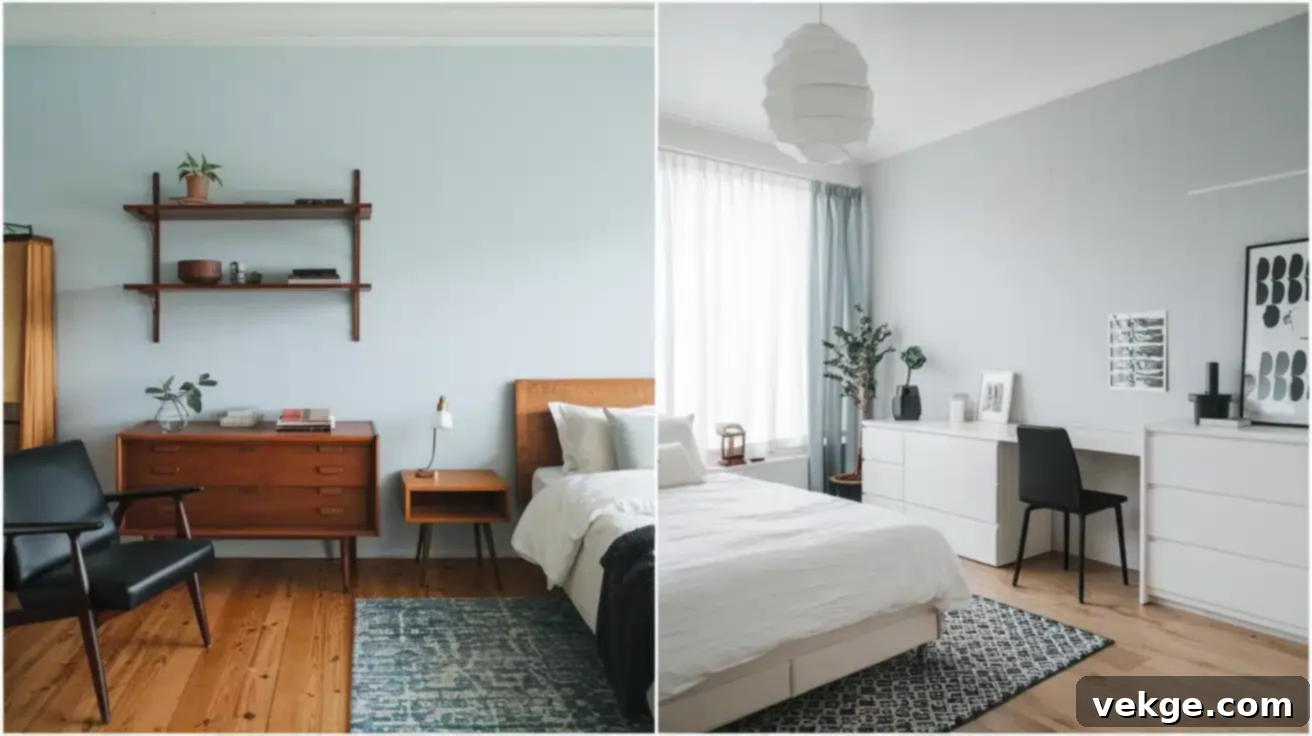
While Japandi and traditional Scandinavian designs share a common appreciation for minimalism and natural elements, they possess distinct characteristics that set them apart. Understanding these differences is key to mastering the Japandi aesthetic:
- Color Palette Nuances: Traditional Scandinavian rooms often favor brighter, cooler whites and pastel accents, creating a light and airy, sometimes stark, feel. Japandi bedrooms, in contrast, lean towards warmer, richer, and more earthy tones. Think creamy off-whites, muted greys, deep charcoal, natural beige, and subtle hints of warm greens or terracotta. This provides a grounding effect and a more mature, refined ambiance.
- Textural Variety: Scandinavian style frequently embraces soft, fluffy textures such as sheepskins, chunky knits, and plush rugs to enhance coziness. Japandi, while still valuing comfort, incorporates a wider range of smoother, more refined surfaces and celebrates the raw, unrefined beauty of natural textures like raw wood grains, smooth ceramics, rough linen, and woven bamboo. This creates a tactile experience that feels both grounded and sophisticated.
- Approach to Decor and Ornamentation: Scandinavian rooms might include a moderate number of decorative items, often showcasing playful patterns or vibrant accents. Japandi spaces, adhering to the principle of “less is more,” keep decor extremely minimal and highly intentional. The focus is on a few carefully selected, meaningful pieces that often serve a dual purpose of beauty and function, preventing visual noise and promoting a sense of calm contemplation.
- Material Finishes: While both use wood, Scandinavian design often features lighter, unfinished woods. Japandi incorporates a mix, including darker, stained woods and more refined finishes, adding depth and contrast.
Crafting Your Japandi Color Palette for the Bedroom
Choosing the right colors is perhaps the most fundamental step in creating an authentic Japandi bedroom. This style masterfully utilizes a specific mix of calm, nature-inspired shades that collectively work to establish a profoundly peaceful and visually expansive sleep space.
Embracing Neutral Tones: Whites, Beiges, and Grays
Neutral colors form the foundational base of any Japandi bedroom. These versatile shades not only create a clean and open feel but also act as a perfect canvas for natural textures and subtle accents:
- Warm Whites: Instead of stark, clinical whites, opt for soft, inviting, and warm whites. Consider creamy off-whites, gentle ivory tones, or eggshell finishes. These shades reflect light beautifully while maintaining a cozy atmosphere, avoiding any harshness.
- Comforting Beiges: Light beige is an excellent choice for adding warmth and a sense of grounding without being overly bold or dominant. It pairs exceptionally well with various natural wood tones and complements a range of earthy hues, creating a cohesive and inviting look.
- Sophisticated Grays: Select light to medium grays to introduce a touch of modernity and depth. These can range from soft, airy dove gray, which evokes a sense of tranquility, to deeper charcoal shades that provide a subtle contrast and anchor the space, especially when used on accent walls or larger furniture pieces.
Introducing Muted Earth Tones and Soft Pastels for Subtle Depth
To add a delicate touch of color and visual interest to your Japandi bedroom without overwhelming the minimalist aesthetic, draw inspiration directly from the natural world:
- Grounding Earth Tones: Incorporate gentle browns, muted greens (like sage or olive), warm terracotta, or subtle rust reds. Think of the rich, calming colors you’d encounter in a serene natural landscape. These tones can be introduced through bedding, throw pillows, ceramic planters, or a piece of understated artwork.
- Barely-There Soft Pastels: If you desire a whisper of color, choose very light, almost ethereal shades of blush pink, dusty blue, or serene lavender. These pastels should be so soft that they almost blend into the neutral background, providing just a hint of charm and gentleness, often seen in textiles or small decorative objects.
11 Inspiring Japandi Bedroom Design Ideas
Japandi bedroom design is all about blending the uncluttered simplicity of Japanese aesthetics with the comforting warmth of Scandinavian coziness to forge incredibly peaceful and stylish personal spaces. These 11 inspirations highlight key elements of this popular and enduring style, offering practical ideas for transforming your bedroom into a truly calming and restorative retreat.
1. Embrace Light Wood Furniture
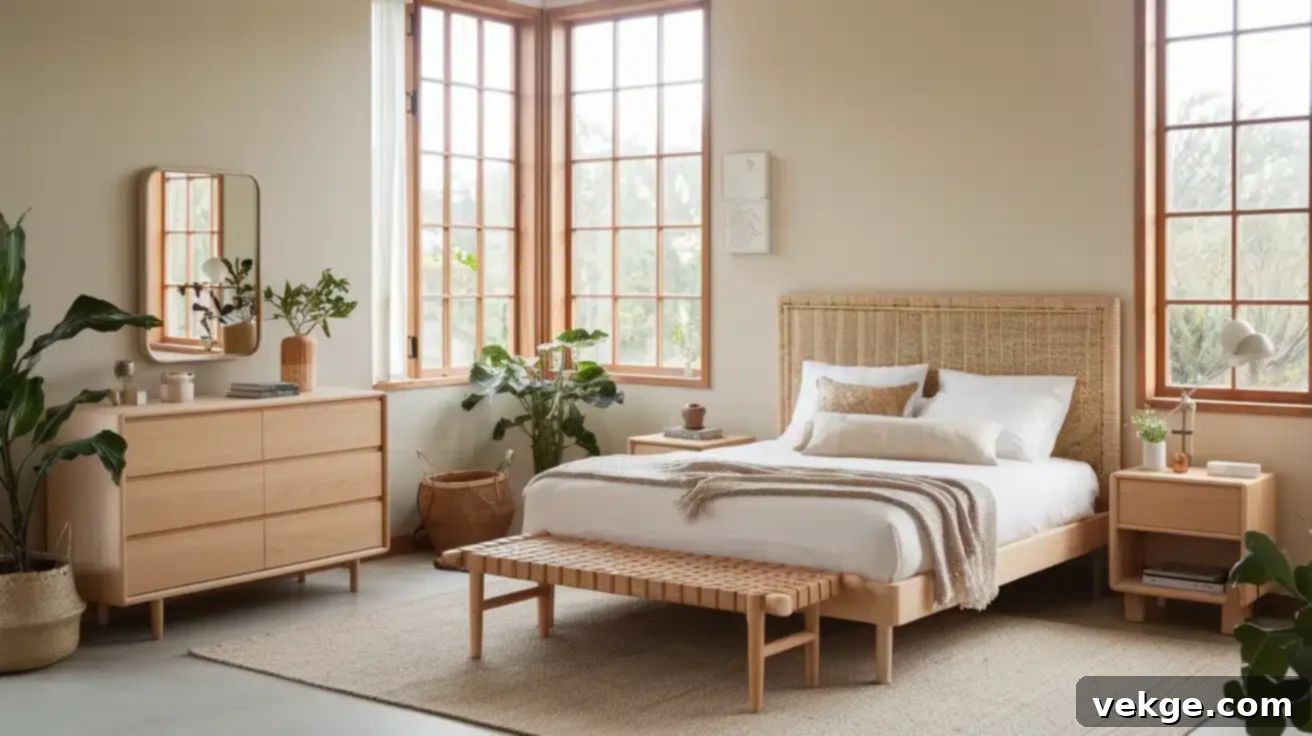
Opt for beds, dressers, and nightstands crafted from pale woods such as ash, birch, or light oak. The natural grains and light tones of these woods are central to both Scandinavian and Japanese design principles. This choice beautifully reflects the Nordic appreciation for bright, airy interiors and the Japanese reverence for natural materials. Light wood furniture instantly creates a bright, expansive, and inviting feel, bringing the serene beauty of nature directly indoors and acting as a neutral foundation for the entire room.
2. Integrate Globe Lighting for Soft Illumination
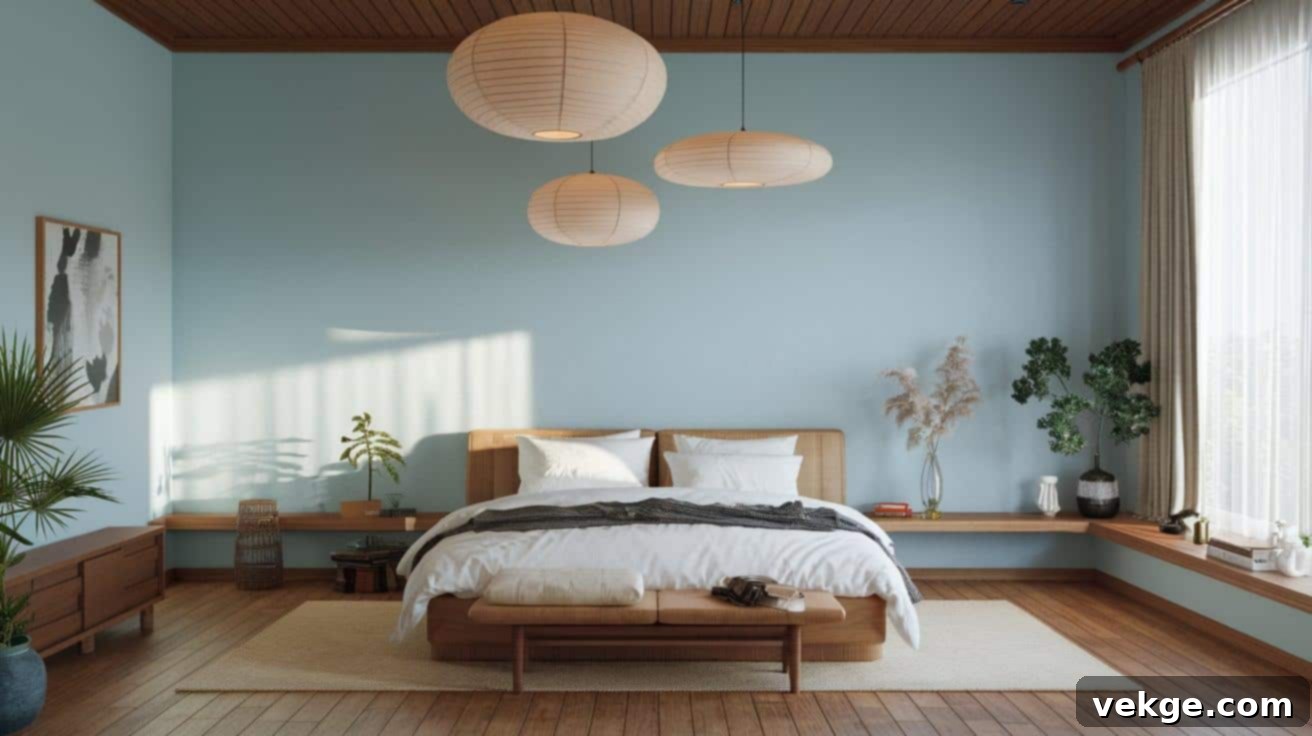
Introduce round, spherical lamps, often made from rice paper, frosted glass, or natural fabric, that emit a soft, diffused, and warm glow. These lights are a perfect fusion of traditional Japanese lantern styles and Scandinavian minimalist design. They provide gentle, ambient lighting that is crucial for creating a cozy, calm, and intimate atmosphere in the bedroom, avoiding harsh shadows and contributing to a sense of tranquil comfort.
3. Adorn Walls with Nature-Inspired Artwork
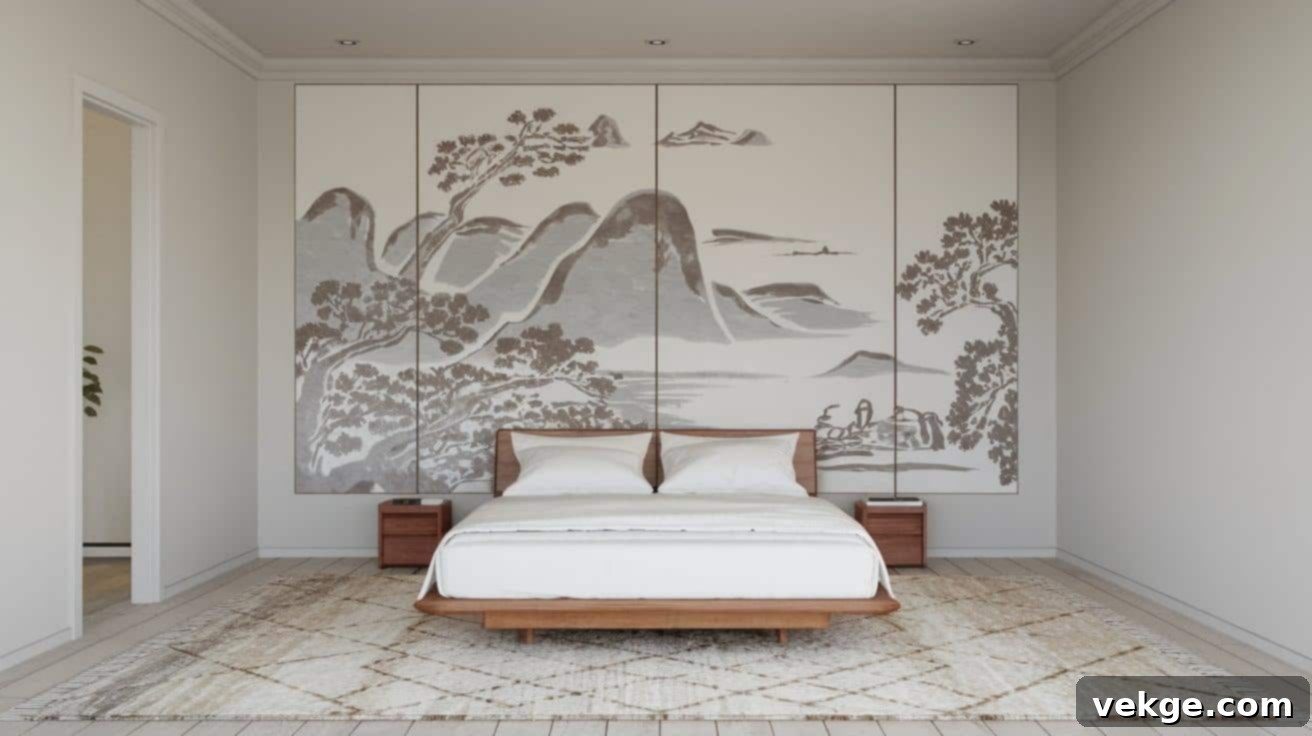
Select wall art that subtly features botanical prints, serene landscapes, abstract interpretations of natural forms, or minimalist line drawings inspired by flora and fauna. This choice directly aligns with the Japanese profound love of nature and the Scandinavian inclination towards understated, organic art. It serves to seamlessly bring the outdoors in, fostering a peaceful, grounded, and harmonious feel within your private sanctuary.
4. Define Spaces with Under-Bed Area Rugs
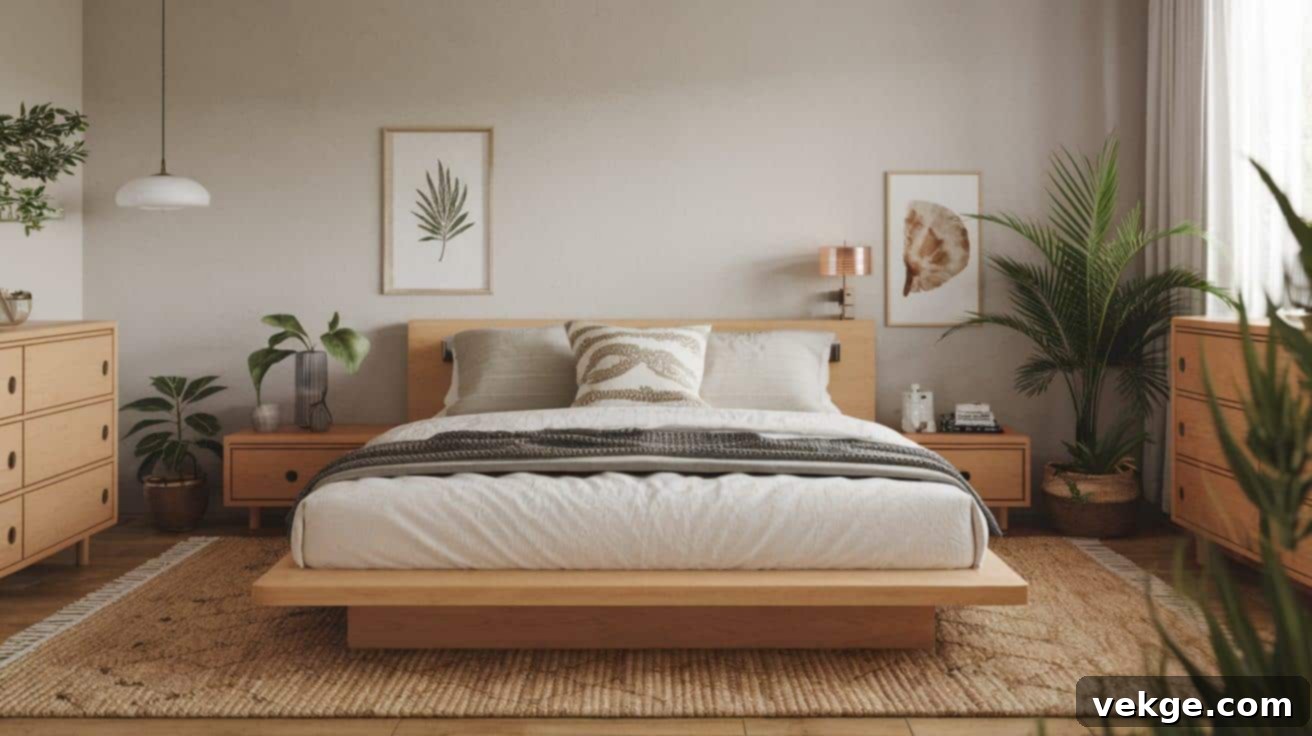
Place soft, natural fiber rugs (such as wool, jute, sisal, or cotton) partially underneath the bed. These rugs serve multiple purposes: they add crucial warmth and inviting texture to the room, reflecting both styles’ deep focus on comfort and tactile experience. The use of natural materials further aligns with Japandi’s strong connection to nature and sustainable living, while defining the sleeping zone within a larger open space.
5. Opt for Low-Profile Bed Frames
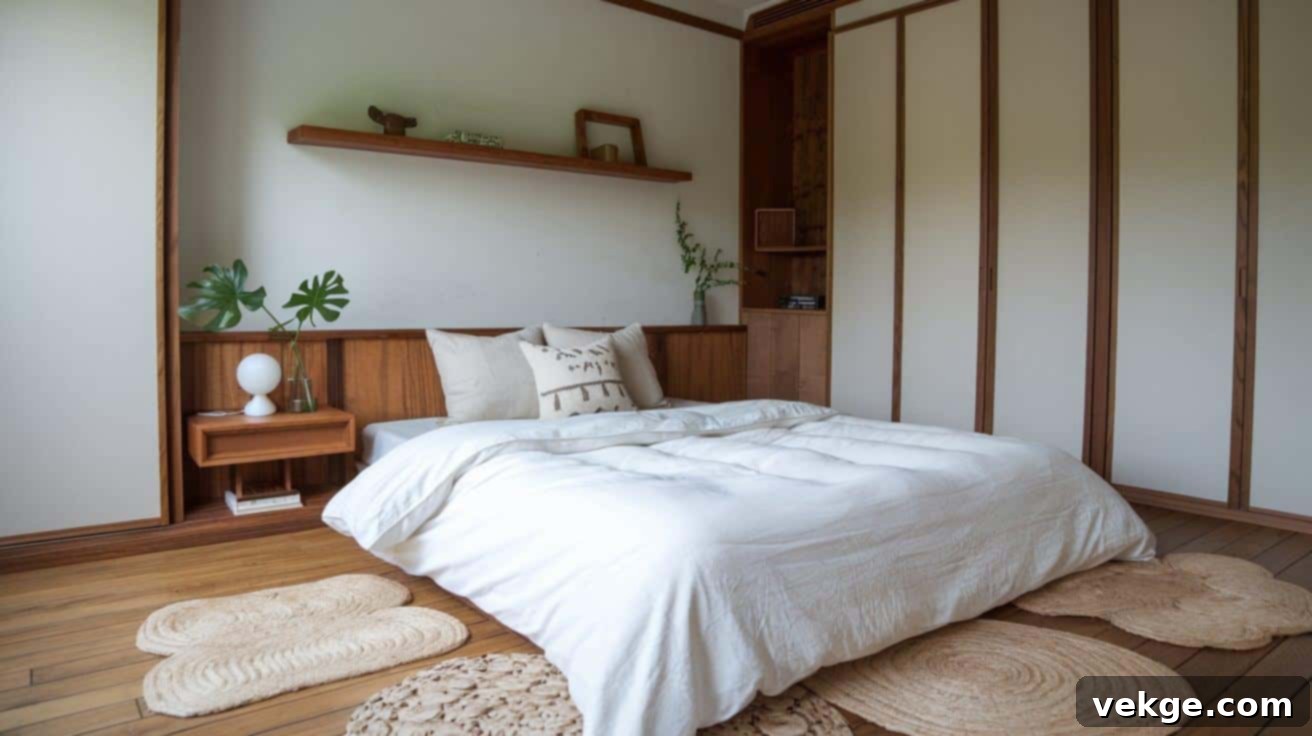
Choose platform beds that sit close to the ground, often featuring sleek, minimalist designs. Low bed frames are a signature element in both traditional Japanese sleep aesthetics and modern Scandinavian design, emphasizing a connection to the earth and creating a visually spacious environment. They instantly evoke a grounded, serene feeling, make the ceiling appear higher, and contribute to an overall sense of calm and openness in the room.
6. Integrate Diverse Natural Materials
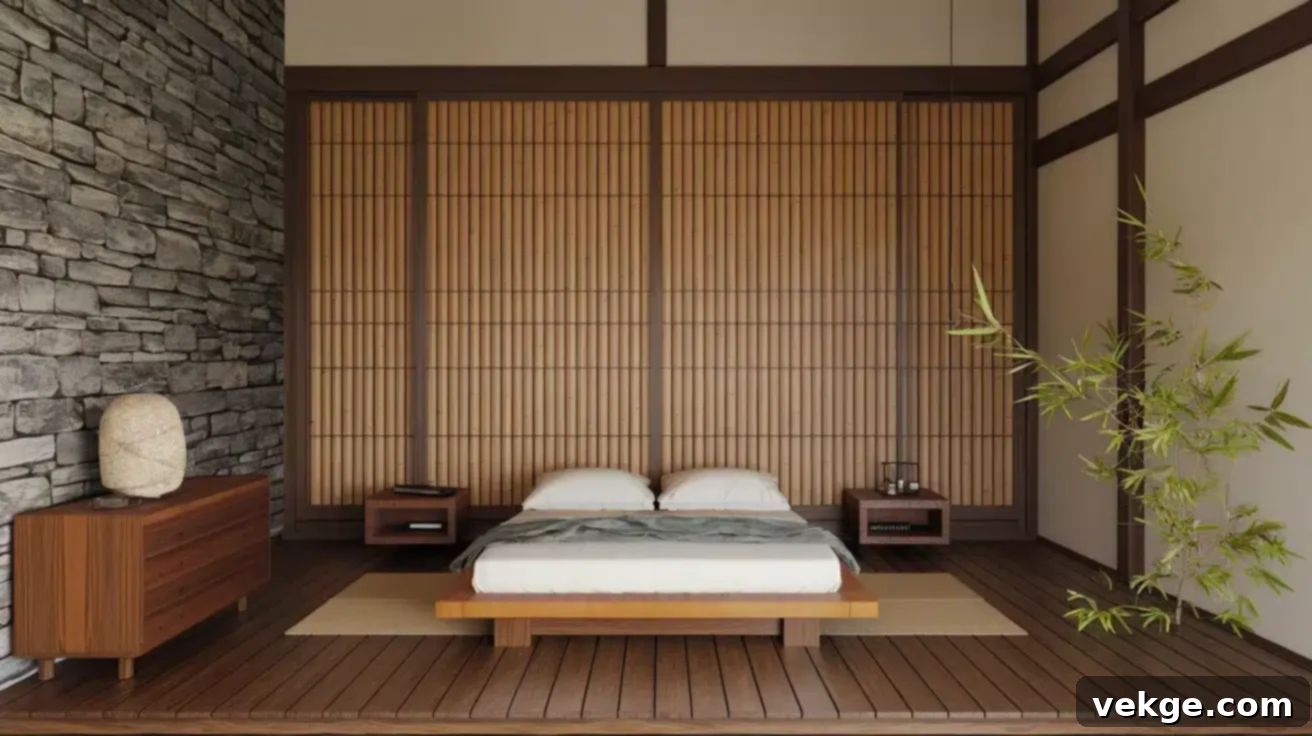
Beyond just wood, intentionally use a variety of natural elements throughout the bedroom. Think linen or cotton bedding, wool throws, bamboo blinds, ceramic vases, terracotta planters, or even subtle stone accents. This reflects both Japanese and Scandinavian cultures’ profound respect for nature and craftsmanship. It creates a rich, organic, and deeply calming sensory experience that is fundamental to the Japandi style, adding depth without clutter.
7. Select a Simple, Elegant Bed (e.g., Bergen Oak Kingsize Bed)

A bed frame like a simple, clean-lined design made from light oak wood exemplifies Japandi principles. Its minimalist form and natural material perfectly encapsulate both Japanese functional beauty and Scandinavian aesthetic simplicity. Such a bed serves as a beautiful, understated, and highly functional centerpiece around which the rest of your tranquil bedroom design can gracefully unfold.
8. Deliberately Work Texture into Your Space
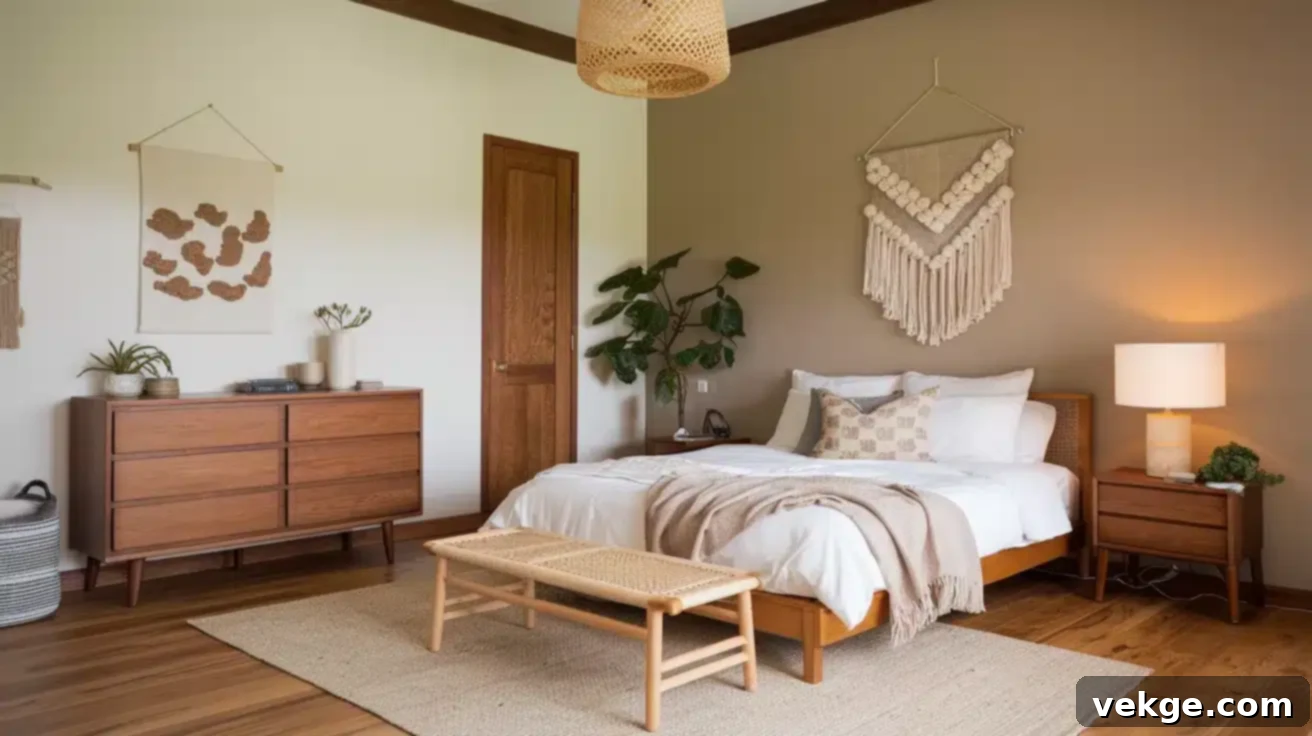
Achieve visual and tactile interest by mixing smooth surfaces (like polished concrete, ceramics, or glass) with rougher, more organic textures. Think soft linen bedding, chunky wool throws, raw wood furniture, or woven baskets. This layering of textures skillfully blends Scandinavian coziness with the Japanese appreciation for natural, imperfect textures (wabi-sabi). It adds significant depth, warmth, and an inviting quality to the room while meticulously maintaining an overall sense of simplicity and restraint.
9. Choose Unique Yet Highly Functional Decor
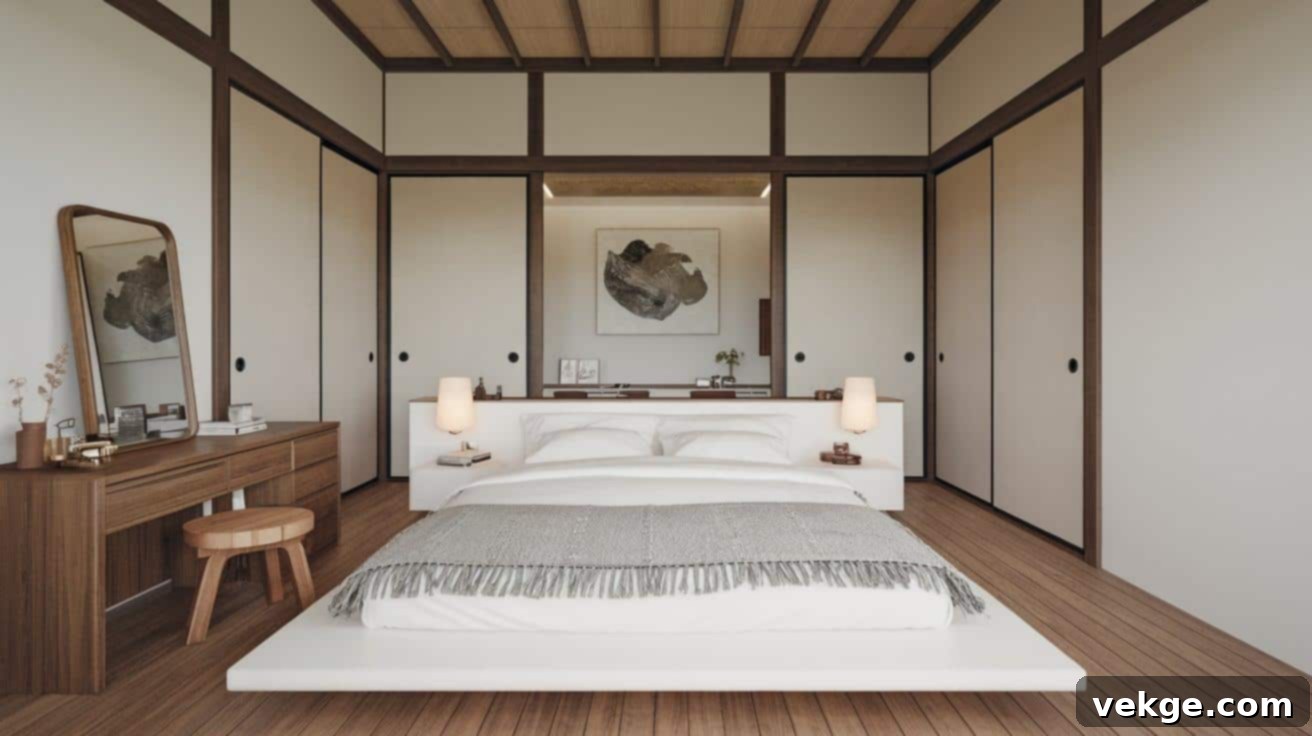
Every decorative item in a Japandi bedroom should be thoughtfully selected for its dual qualities of beauty and utility. Embrace the Japanese concept of practical beauty and the Scandinavian focus on functionality. This means opting for items like a sculptural ceramic dish that holds jewelry, a beautifully designed lamp that provides essential light, or a single, elegant plant that purifies the air. Each piece must serve a clear purpose while simultaneously enhancing the room’s refined style without creating visual clutter.
10. Minimalist Japandi Bedroom With Plywood Doors
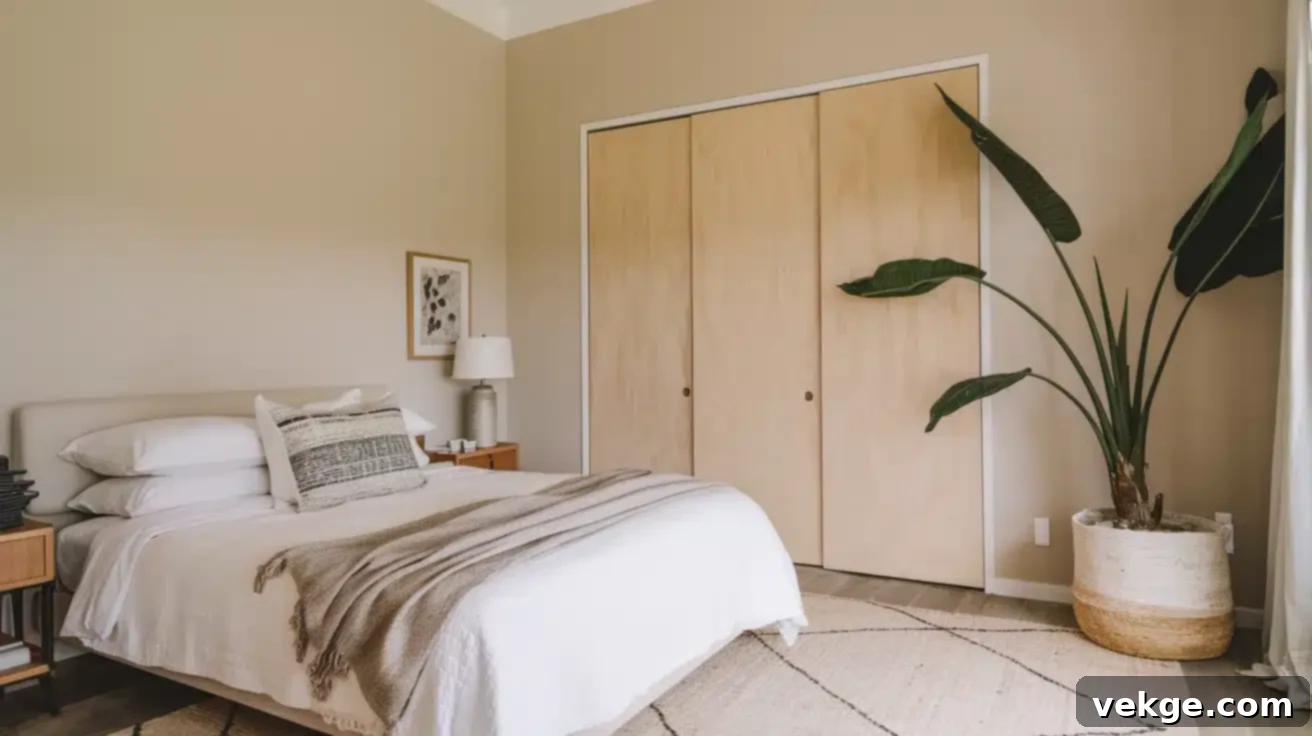
Consider a bedroom featuring smooth, light-toned plywood closet doors alongside minimal furnishings. The use of plywood perfectly embodies the Japandi love for simple, honest, and natural materials, often chosen for its understated beauty and sustainability. The minimalist application throughout the space, with clean lines and uncluttered surfaces, powerfully reflects both Japanese and Scandinavian cultures’ shared preference for serene, organized, and harmonious living environments.
11. Modern Japandi Bedroom With Vertical Oak Wood Slats
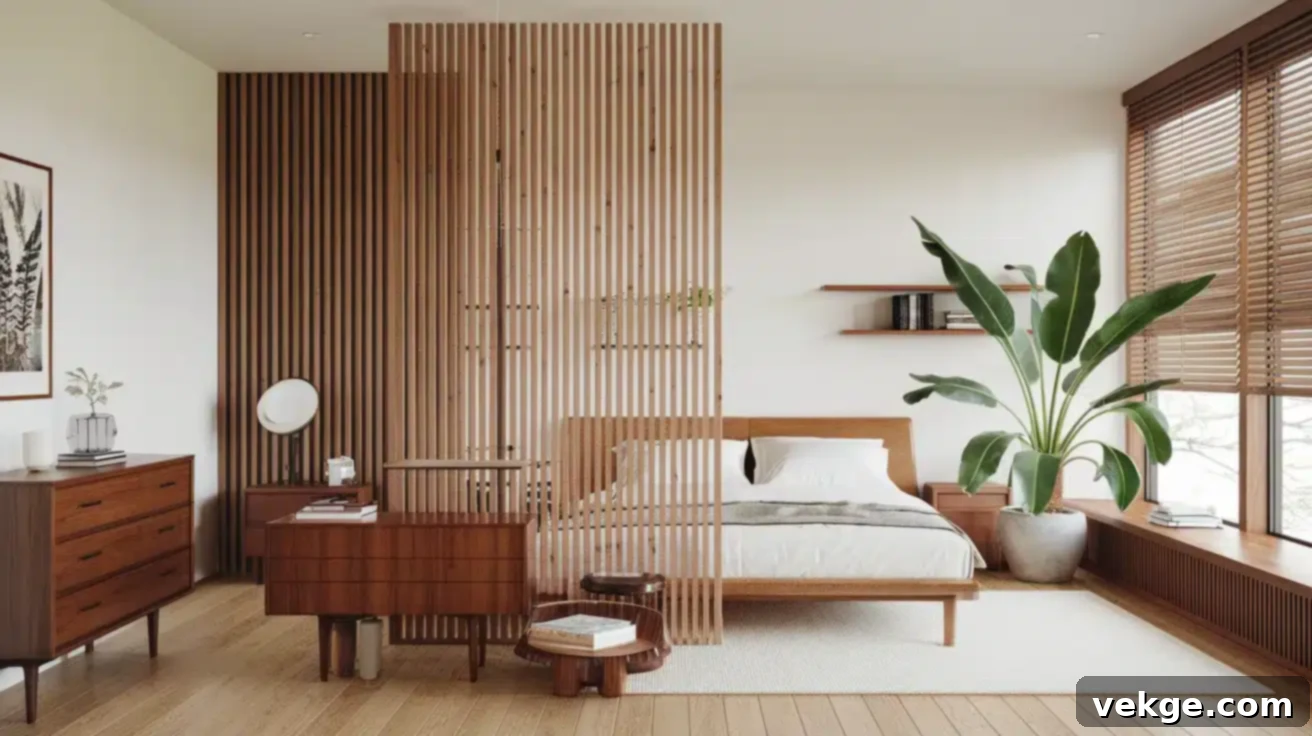
Create a striking architectural feature by incorporating a wall or a partial divider made of vertical oak wood slats. This design element introduces rich natural wood texture in a contemporary and sophisticated manner. It brilliantly combines traditional Japanese architectural screening elements with Scandinavian craftsmanship and appreciation for timber. This feature adds visual interest, depth, and a subtle sense of division without sacrificing the open, airy feel of a Japandi space, often used behind the bed as a feature wall.
Essential Steps to Create Your Dream Japandi Bedroom
Creating a Japandi bedroom is a journey toward achieving perfect harmony between the profound simplicity of Japanese design and the inviting comfort of Scandinavian aesthetics. Follow these practical steps to effectively blend natural materials, minimalist furniture, and a calming color scheme, crafting your ultimate Japandi retreat.
1. Choose a Calming and Cohesive Color Scheme
- Start with Neutrals: Begin by selecting soft, neutral wall colors. Think warm whites (like ivory or cream), gentle off-whites, or serene light grays (like dove gray). These provide a clean, expansive, and tranquil backdrop.
- Layer with Earth Tones: Introduce subtle depth using muted earth tones. Incorporate soft beiges, warm browns, olive greens, or even muted terracotta in textiles, small decor items, or accent cushions.
- Balance Light and Dark: While neutrals dominate, don’t shy away from incorporating darker shades sparingly to create contrast and anchor the space. Charcoal gray or dark wood accents can add sophistication without overwhelming the calm atmosphere.
2. Prioritize and Incorporate Natural Materials
- Furniture Choices: Select simple, well-crafted wooden furniture pieces (beds, nightstands, dressers) with clean lines. Light woods like oak, birch, or ash are ideal, but darker, warm woods can also be used for contrast.
- Organic Textiles: Opt for bedding, curtains, and throws made from organic, natural fibers such as linen, cotton, hemp, or wool. These materials offer tactile warmth, breathability, and an authentic connection to nature.
- Accessorize Naturally: Introduce elements like bamboo, rattan, ceramic, stoneware, or even polished concrete in your accessories (vases, lamps, trays) to reinforce the natural aesthetic.
3. Select Minimalist and Functional Furniture
- Low-Profile Beds: A cornerstone of Japandi, choose low-profile bed frames, often platform style, to create a grounded, spacious, and inviting feel. This promotes a sense of calm and openness.
- Clean Lines: Opt for furniture pieces characterized by simple, uncluttered forms and straight lines. Avoid ornate details, excessive carvings, or overly decorative elements.
- Integrated Storage: Prioritize furniture that offers ample, discreet storage solutions to maintain a clutter-free environment. Built-in drawers, sleek wardrobes, and closed shelving units are ideal for preserving visual calm.
4. Thoughtfully Add Textures Through Textiles and Elements
- Layer Bedding: Create depth and comfort by layering different natural textures in your bedding. Combine smooth cotton sheets with a linen duvet cover and a chunky knitted wool throw.
- Introduce Rugs: Add warmth and define zones with a natural fiber rug (jute, wool, sisal) placed under the bed or in a seating area. Choose rugs with subtle patterns or plain textures.
- Woven Elements: Incorporate woven curtains, blinds, or even baskets for storage. These elements add an organic, handcrafted feel that is central to Japandi style, softening the space.
5. Declutter and Embrace Intentional Living
- Purge ruthlessly: Remove anything that doesn’t serve a purpose or bring you joy. A clutter-free space is fundamental to Japandi’s serene atmosphere.
- Concealed Storage: Utilize closed storage for items you need but don’t want on display. This helps maintain the clean, minimalist aesthetic.
- Mindful Placement: Every item that remains should have a designated place and be thoughtfully arranged, contributing to the overall sense of order and tranquility.
Japandi Bedroom Furniture and Accessories Guide
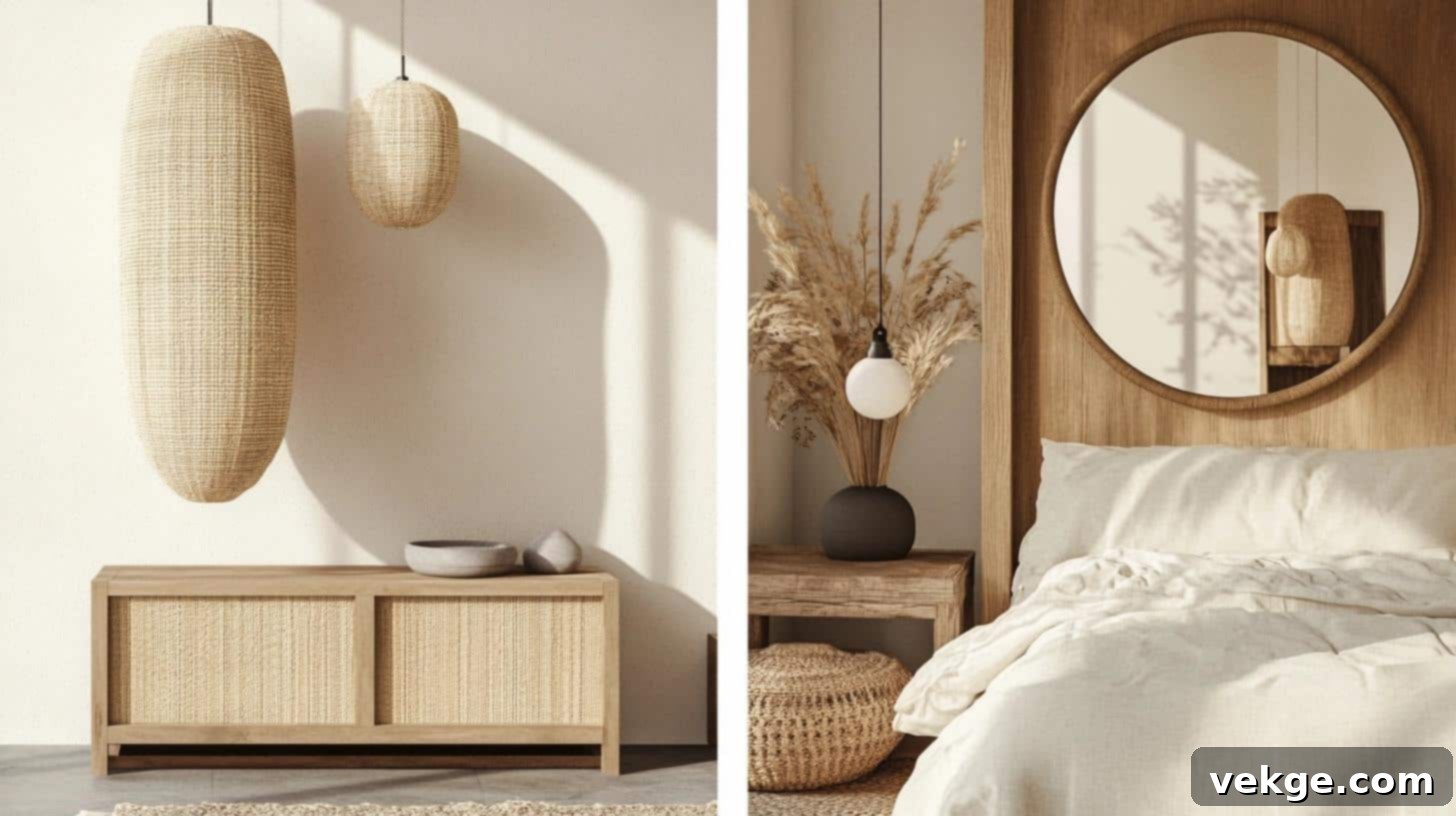
Creating a truly authentic Japandi bedroom involves a meticulous and careful selection of furniture and accessories that seamlessly blend the best elements of Japanese and Scandinavian design. Here’s a comprehensive guide designed to help you choose the perfect pieces that will define and enhance your serene space:
Key Furniture Recommendations for Your Japandi Bedroom
| Furniture Type | Detailed Recommendations for Japandi Style |
|---|---|
| Bed Frames |
|
| Nightstands |
|
| Dressers & Storage |
|
Inspiring Accessory Ideas for Your Japandi Bedroom
| Category | Detailed Recommendations for Japandi Style |
|---|---|
| Lighting |
|
| Decor & Art |
|
| Textiles & Soft Furnishings |
|
Where to Shop for Japandi Decor Items
Online Retailers & Brands to Explore:
- Muji: Renowned for its minimalist Japanese design, functional household goods, and quality essentials that perfectly embody Japandi simplicity and utility.
- IKEA: Offers a vast array of affordable Scandinavian-inspired furniture and decor pieces. Look for items with clean lines, light wood finishes, and neutral color palettes.
- West Elm: Provides a sophisticated mix of modern and natural elements, with many pieces that effortlessly fit the Japandi aesthetic, particularly in furniture and lighting.
- Etsy: An excellent marketplace for discovering unique, handcrafted ceramic pieces, custom art prints, and artisan-made textiles that offer a touch of wabi-sabi charm.
- H&M Home / Zara Home: Often feature on-trend decorative items, bedding, and smaller furniture pieces that can be integrated into a Japandi scheme at an accessible price point.
- Local Artisan Shops: Explore local craft markets or independent design stores for unique, handmade items like pottery, wooden bowls, or textiles that celebrate natural materials and craftsmanship.
Conclusion: Cultivating Your Japandi Sanctuary
Creating a Japandi bedroom is a journey that beautifully culminates in finding perfect harmony between the profound simplicity of Japanese aesthetics and the comforting, inviting principles of Scandinavian design. This unique and thoughtful style offers far more than just a visually appealing room; it provides a genuine, peaceful retreat from the relentless pace of the busy world, deeply focusing on minimalism, natural elements, authenticity, and exceptionally thoughtful design.
By consciously choosing a calm and coherent color palette, deliberately incorporating an abundance of natural materials, and meticulously selecting minimalist yet highly functional furniture, you hold the power to transform your bedroom into a serene, Japandi-inspired sanctuary. Remember to add subtle, varied textures through textiles and organic elements, to choose accessories that are both beautiful and genuinely useful, and to consider eco-friendly and sustainable options to truly embrace the holistic essence of this style.
Ultimately, a Japandi bedroom transcends mere aesthetics—it’s about mindfully crafting a space that actively promotes deep relaxation, personal well-being, and a sense of enduring calm. By diligently applying the ideas and principles outlined in this comprehensive guide, your bedroom will undoubtedly become a calming haven, beautifully reflecting the very best of both design worlds, fostering tranquility, and enriching your daily life.
We sincerely hope this detailed guide has inspired you to explore the captivating world of Japandi style and empowers you to create your own perfectly balanced, serene, and restorative sleeping space.
FAQ (Frequently Asked Questions) About Japandi Bedrooms
Can I Incorporate Existing Furniture into a Japandi Design?
Absolutely, you can certainly incorporate some of your existing furniture into a Japandi design, especially if you select carefully. The key is to focus on pieces that already possess clean lines, simple forms, and are made from natural materials. To integrate them successfully, prioritize simplifying your space by decluttering rigorously and only keeping items that serve a clear purpose or hold significant meaning. Sometimes, a fresh coat of paint in a neutral tone or a change of hardware can help existing furniture blend seamlessly into the Japandi aesthetic.
Is Japandi Style Suitable for Small Bedrooms?
Yes, Japandi style is exceptionally well-suited for small bedrooms, making it an ideal choice for maximizing space and creating an illusion of openness. The style’s inherent emphasis on minimalism, functionality, and uncluttered spaces works wonders in compact areas. To optimize a small Japandi bedroom, utilize a light, neutral color palette to make the room feel larger, opt for multi-functional furniture (like a bed with built-in storage), and keep decorations to a bare minimum, focusing on a few impactful, high-quality pieces. Low-profile furniture also helps to open up the vertical space.
What About Incorporating Plants in a Japandi Bedroom?
Plants are a wonderful and highly encouraged addition to a Japandi bedroom, as they reinforce the style’s deep connection to nature and bring vital organic energy into the space. Choose elegant, simple plants with clean lines, such as a Snake Plant, ZZ Plant, or a Fiddle Leaf Fig. Opt for minimalist planters made from natural materials like ceramic, terracotta, or unglazed pottery in muted colors. The idea is to bring in greenery thoughtfully and sparingly, allowing each plant to be a focal point that enhances the room’s serene atmosphere without creating clutter.
Is Japandi Design an Expensive Style to Implement?
Japandi design can be implemented across various budgets. While it emphasizes quality and natural materials, which can sometimes be pricier, its core principle of “less is more” means you don’t need a lot of items. Investing in a few key, well-made pieces (like a good wooden bed frame) and then sourcing more affordable, simple items for textiles and decor from retailers like IKEA or even DIY options for natural elements can keep costs down. Focus on quality over quantity, and prioritize natural textures and neutral colors, which are often timeless and accessible.
